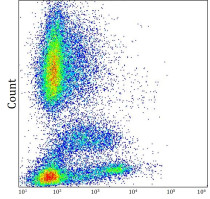ARG43856
anti-CD56 / NCAM antibody [LT56] (PE-Cyanine 5)
anti-CD56 / NCAM antibody [LT56] (PE-Cyanine 5) for Flow cytometry and Human
Overview
| Product Description | PE-Cyanine 5-conjugated Mouse Monoclonal antibody human CD56 / NCAM |
|---|---|
| Tested Reactivity | Hu |
| Tested Application | FACS |
| Host | Mouse |
| Clonality | Monoclonal |
| Clone | LT56 |
| Isotype | IgG2a |
| Target Name | CD56 / NCAM |
| Antigen Species | Human |
| Immunogen | KG1a Cell line |
| Conjugation | PE-Cyanine 5 |
| Protein Full Name | Neural cell adhesion molecule 1 |
| Alternate Names | NCAM1; Neural Cell Adhesion Molecule 1; NCAM; CD56; Antigen Recognized By Monoclonal Antibody 5.1H11; Neural Cell Adhesion Molecule, NCAM; CD56 Antigen; N-CAM-1; NCAM-1; MSK39 |
Application Instructions
| Application Suggestion |
|
||||
|---|---|---|---|---|---|
| Application Note | * The dilutions indicate recommended starting dilutions and the optimal dilutions or concentrations should be determined by the scientist. |
Properties
| Form | Liquid |
|---|---|
| Purification | Protein-A affinity chromatography |
| Buffer | PBS (pH 7.4) and 15 mM Sodium azide |
| Preservative | 15 mM Sodium azide |
| Storage Instruction | Aliquot and store in the dark at 4°C. Keep protected from prolonged exposure to light. Do not freeze. Suggest spin the vial prior to opening. The antibody solution should be gently mixed before use. |
Bioinformation
| Database Links | |
|---|---|
| Gene Symbol | NCAM1 |
| Gene Full Name | Neural Cell Adhesion Molecule 1 |
| Background | This gene encodes a cell adhesion protein which is a member of the immunoglobulin superfamily. The encoded protein is involved in cell-to-cell interactions as well as cell-matrix interactions during development and differentiation. The encoded protein plays a role in the development of the nervous system by regulating neurogenesis, neurite outgrowth, and cell migration. This protein is also involved in the expansion of T lymphocytes, B lymphocytes and natural killer (NK) cells which play an important role in immune surveillance. This protein plays a role in signal transduction by interacting with fibroblast growth factor receptors, N-cadherin and other components of the extracellular matrix and by triggering signalling cascades involving FYN-focal adhesion kinase (FAK), mitogen-activated protein kinase (MAPK), and phosphatidylinositol 3-kinase (PI3K). One prominent isoform of this gene, cell surface molecule CD56, plays a role in several myeloproliferative disorders such as acute myeloid leukemia and differential expression of this gene is associated with differential disease progression. For example, increased expression of CD56 is correlated with lower survival in acute myeloid leukemia patients whereas increased severity of COVID-19 is correlated with decreased abundance of CD56-expressing NK cells in peripheral blood. Alternative splicing results in multiple transcript variants encoding distinct protein isoforms. |
| Function | This protein is a cell adhesion molecule involved in neuron-neuron adhesion, neurite fasciculation, outgrowth of neurites, etc. |
| Cellular Localization | Cell membrane, Membrane, Secreted |
| Calculated MW | 95 kDa |
| PTM | Disulfide bond, Glycoprotein, GPI-anchor, Lipoprotein, Phosphoprotein |
Images (1) Click the Picture to Zoom In






